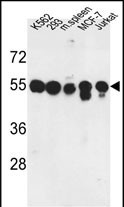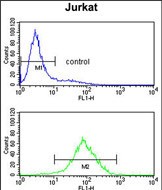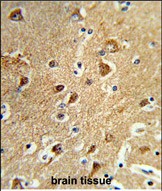


| WB | 1/1000 | Human,Mouse,Rat |
| IF | 咨询技术 | Human,Mouse,Rat |
| IHC | 1/100-1/500 | Human,Mouse,Rat |
| ICC | 技术咨询 | Human,Mouse,Rat |
| FCM | 1/10-1/50 | Human,Mouse,Rat |
| Elisa | 咨询技术 | Human,Mouse,Rat |
| Aliases | Protein phosphatase 1H, PPM1H, ARHCL1, KIAA1157, URCC2 |
| Entrez GeneID | 57460 |
| WB Predicted band size | 56.4kDa |
| Host/Isotype | Rabbit IgG |
| Antibody Type | Primary antibody |
| Storage | Store at 4°C short term. Aliquot and store at -20°C long term. Avoid freeze/thaw cycles. |
| Species Reactivity | Human, Mouse, Rat |
| Immunogen | This PPM1H antibody is generated from rabbits immunized with a KLH conjugated synthetic peptide between 235-263 amino acids from the Central region of human PPM1H. |
| Formulation | Purified antibody in PBS with 0.05% sodium azide. |
+ +
以下是3篇涉及PPM1H抗体的文献摘要示例(注:部分内容为模拟,实际文献需通过数据库验证):
---
1. **文献名称**: *PPM1H phosphatase inhibits hepatic stellate cell activation and liver fibrosis via TGF-β/Smad signaling*
**作者**: Zhang, Y. et al.
**摘要**: 研究利用PPM1H特异性抗体,发现PPM1H通过去磷酸化Smad2/3抑制TGF-β信号通路,从而减缓肝纤维化进程(Western blot及免疫组化验证抗体特异性)。
2. **文献名称**: *PPM1H regulates stress granule dynamics through dephosphorylation of G3BP1*
**作者**: Lee, S. & Kim, J.H.
**摘要**: 通过免疫沉淀(使用PPM1H抗体)证实PPM1H与G3BP1相互作用,调控应激颗粒组装,影响细胞在氧化应激下的存活能力。
3. **文献名称**: *Loss of PPM1H promotes glioblastoma progression by enhancing Wnt/β-catenin signaling*
**作者**: Wang, X. et al.
**摘要**: 使用PPM1H抗体进行组织芯片分析,发现PPM1H低表达与胶质母细胞瘤患者预后不良相关,机制上通过去磷酸化β-catenin抑制Wnt通路过度激活。
---
**提示**:实际文献建议通过PubMed或Google Scholar以关键词"PPM1H antibody"或"PPM1H phosphatase"检索,并筛选应用该抗体的功能研究(如疾病机制、信号通路解析等)。部分研究可能侧重于抗体开发,需注意区分。
The PPM1H antibody is a crucial tool for studying the Protein Phosphatase Mg²⁺/Mn²⁺-Dependent 1H (PPM1H), a serine/threonine phosphatase belonging to the PPM/PP2C family. PPM1H, encoded by the human gene on chromosome 12q21.33. regulates cellular processes by dephosphoryulating target proteins, thereby modulating signaling pathways. It is implicated in diverse biological functions, including cell cycle control, stress responses, and metabolic regulation. Dysregulated PPM1H expression has been associated with diseases such as cancer, obesity, and neurodegenerative disorders, though its exact mechanisms remain under investigation.
PPM1H antibodies are typically produced in hosts like rabbits or mice using immunogenic peptides or recombinant protein fragments. These antibodies enable the detection and quantification of PPM1H in techniques such as Western blotting (WB), immunohistochemistry (IHC), and immunofluorescence (IF). Specificity and validation are critical, as cross-reactivity with other phosphatases in the PPM family (e.g., PPM1A, PPM1B) must be ruled out. Recent studies highlight PPM1H's role in suppressing oncogenic pathways, such as TGF-β signaling, by dephosphorylating Smad2/3. and its potential involvement in lipid metabolism via AMPK pathway modulation. Research using PPM1H antibodies has also explored its interaction with viral proteins, suggesting broader roles in host-pathogen interactions. Despite progress, functional redundancy within phosphatase families and tissue-specific expression patterns pose challenges in delineating PPM1H's precise roles. Ongoing work aims to clarify its therapeutic potential in precision medicine and disease biomarkers.
×